Disclosure: Meeple Mountain received a free copy of this product in exchange for an honest, unbiased review. This review is not intended to be an endorsement.
Barry Steakfries, a struggling gramophone salesman, wanders the city streets feeling down and kicking sidewalk rocks as he contemplates what to do about the decline in sales. Suddenly, he arrives at a not-so discreet “top secret” laboratory where scientists are testing experimental jetpacks. Thinking about all the good he could do with a jetpack, like saving kittens or stopping criminals, he bursts into the laboratory, rips off his suit sleeves, straps on the jetpack, and away he goes.
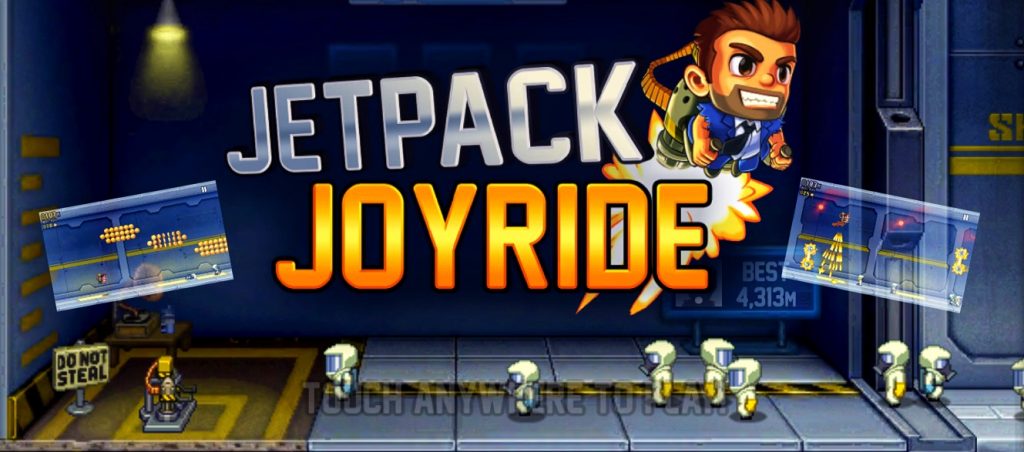
Jetpack Joyride was first released as an iOS video game in 2011 by Halfbrick Studios following their hit game, Fruit Ninja. Jetpack Joyride is a side-scrolling, endless runner game in which you are traveling through a laboratory using a stolen bullet-powered jetpack. In this fast-paced video game, you are trying to travel as far as possible through the lab, collect coins, avoid obstacles and hazards, and complete missions. Lucky Duck Games is attempting to capture the same energy and tension of the award-winning digital game and transform it into a tabletop experience with the Jetpack Joyride board game. Have they succeeded in capturing the original spirit? Continue reading to find out.

Making a Lab for Yourself
To set up the game, each player takes a random set of lab sector cards, numbered from 1 to 4, and arranges them from left to right in ascending numerical order. The pool of polyomino track tiles is set up in the center of the table within easy reach of all players. When playing with fewer than 4 players, a number of track tiles will be returned to the box. Three Mission cards are revealed from the Mission deck and the Gadget cards are set aside in a facedown pile for the first round of play.
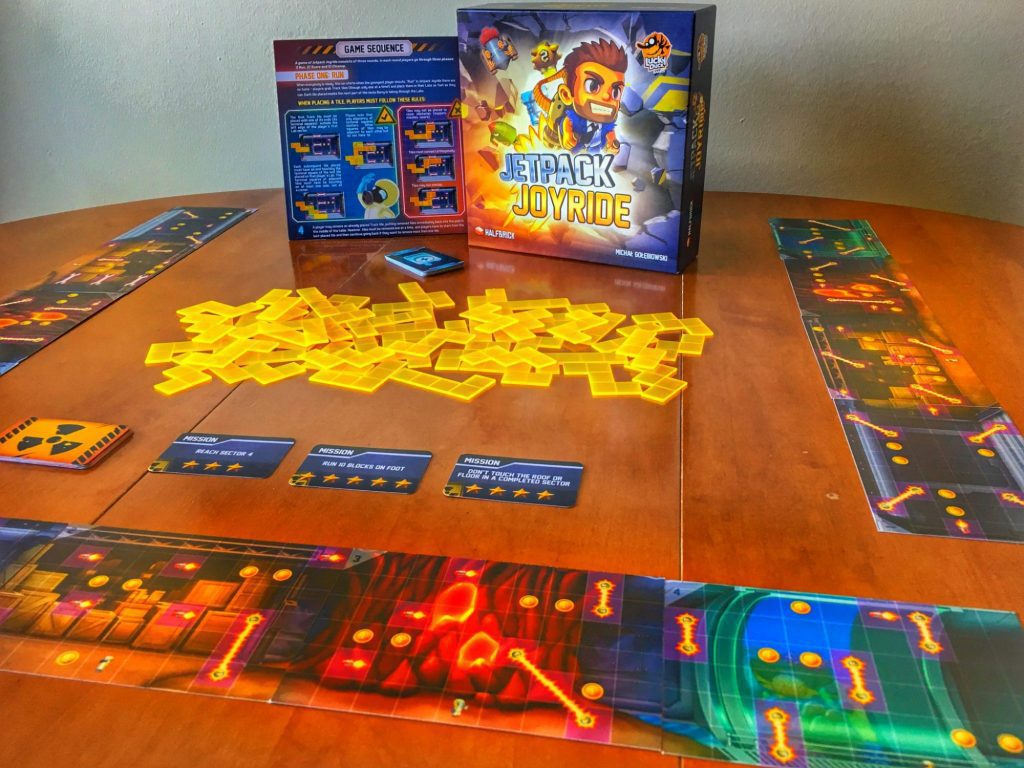
See Barry Run!
A game of Jetpack Joyride is played over 3 rounds runs which consist of 3 phases: Run, Score, and Cleanup. Similar to the digital game, players are trying to escape their own lab, collect coins along the way, and complete the 3 missions for the run.
Run
The first phase, Run, is played in real-time and requires players to grab track tiles from the shared pool and place them on their lab card. Players must only take one tile at a time and follow the placement rules (i.e., a tile placed must touch at least one side of the terminal square of the last tile placed). These tiles will create the path that is taken through the lab and anything covered by these track tiles will affect scoring in the second phase.
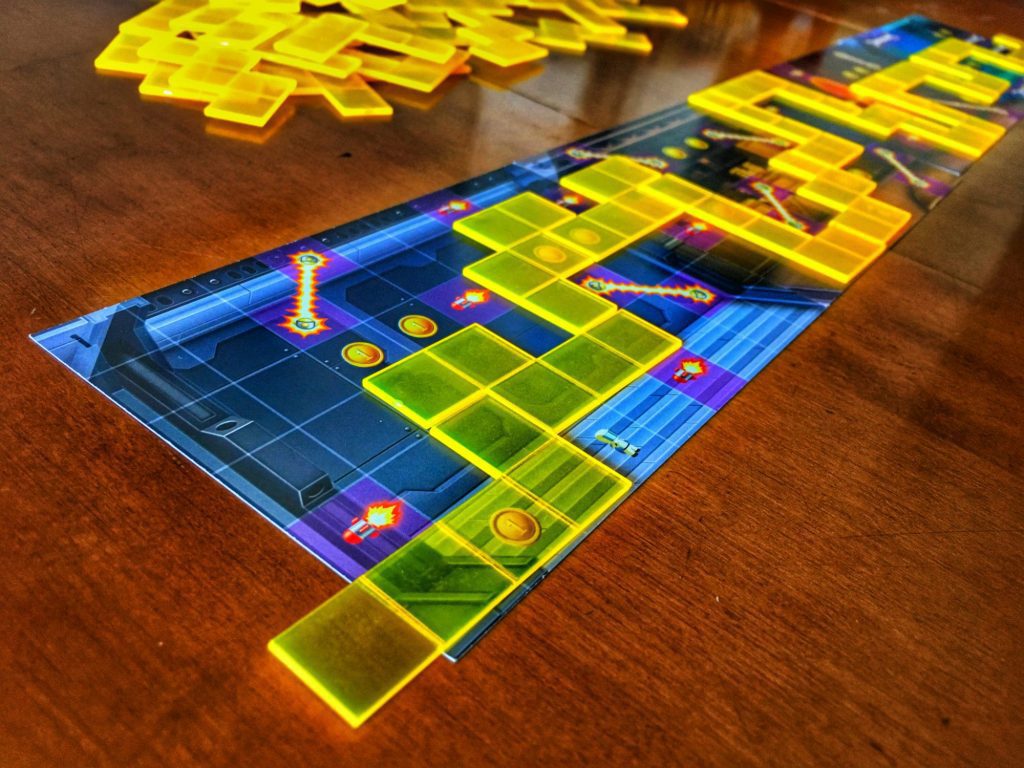
Once a player escapes their lab, no tiles remain in the pool, or each player passes, the Run phase ends immediately and the Score phase begins.
Score
In the Score phase, each player will gain 1 point for each coin they collected in the run (by having a track tile over it) and points equal to the number of stars on the Mission card they completed. Each Mission may be completed by more than one player, but each player may only score each Mission once. Players will lose 3 points for each track tile placed that violates any of the placement rules, including tiles placed over zappers, lasers, or missiles.

Cleanup
Once all players’ scores have been tallied for the run, a number of Gadget cards equal to the number of players is revealed. Beginning with the player who scored the lowest in the run, each player picks one of the revealed Gadget cards. These cards will either allow players to break placement rules or provide more opportunities to score points in subsequent runs. Players will use and keep the Gadget cards they acquired for the remainder of the game.
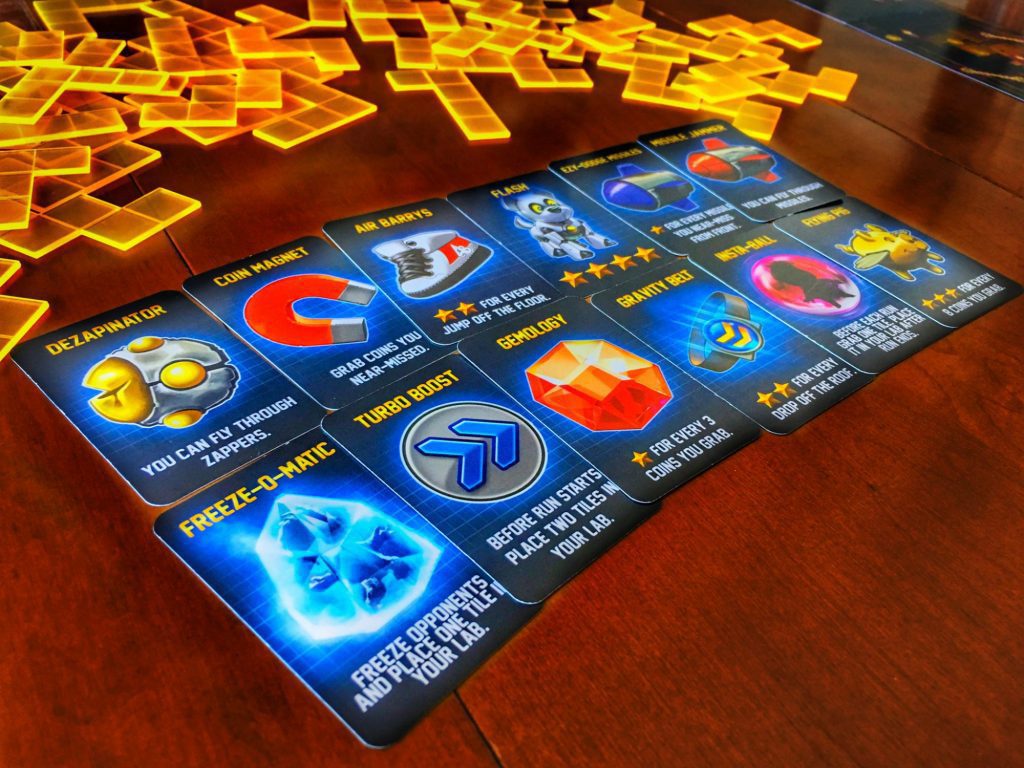
In the final phase, after the first and second runs, players remove all the track tiles from their lab cards returning them to the common pool and pass their 4 lab cards to the player on their left. Then the previous run’s Mission cards are discarded and 3 new ones are revealed. Play continues following these phases until 3 runs have been completed. Then players will total their scores from each run to determine the winner of the game.
Flying Solo
Jetpack Joyride has a well-developed solo variant that changes the pace of the multiplayer game from fast and stressful to a tense puzzle. The setup of the solo variant is similar to that of the multiplayer game except a few Mission and Gadget cards are removed from the game, as well as 10 track tiles (2 of each shape).

The phases and runs remain the same, except for each run’s Cleanup phase. Solo players will receive a new set of lab cards and will reveal 3 new Mission cards, but the used track tiles are returned to the game box and removed from the game instead of being returned to the pool. This means that each tile will only be used once per game. After 3 runs of solo play, total your score from each run and compare your score to the punny table in the rulebook to see how well you did.
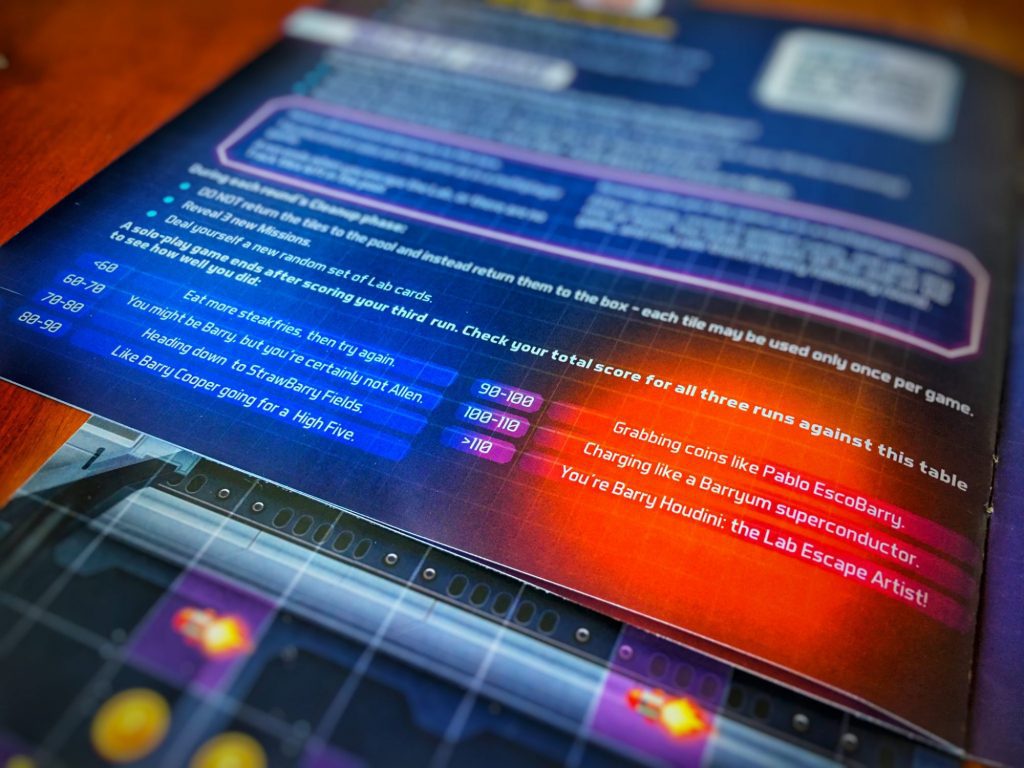
Daring to Compare
Since this board game is based on a digital game, it is only fair to compare both gameplay experiences. Designer Michał Gołębiowski and publisher Lucky Duck Games have done an excellent job recreating the digital gameplay experience in analog format. When you are playing the digital game, the further and faster you travel through the lab, the more you feel this intense anxiety that one wrong move could be the end of your run. Eventually, you abandon your strategy because, at that point, survival is all that matters. Lucky Duck Games have captured this tension by having players frantically grab track tiles one at a time from a shared pool, while hoping that the first one their fingers touch will be good enough to fit on their lab card and score some points. Sometimes it is not and you have to drop your strategy to try to make the remaining track pieces work.
This board game also captures the spirit of unfamiliarity in the digital game by ensuring that a player has a new set of lab cards for each run. The board game also carries over missions, gadgets, and their functions from the digital version. Other similarities between the digital and analog game like having 3 active missions each run, the build up to getting gadgets, and the option to only ever equip 2 gadgets at a time are more minute, yet still impressive.
What is great about this board game is that the gameplay doesn’t only appeal to those who have played the digital Jetpack Joyride game. Having experience with the digital gameplay helps a player understand the rules and purpose a little more intuitively, but they have no strategic advantage.
Final Thoughts
Admittedly, I was skeptical about how good this game would be when I first heard about it. It seemed like the designer and publisher were setting themselves up for quite a difficult ride trying to bring this digital game to the table. Add to that, the hesitation I always have about board games featuring licensed IP from video games or movies. However, I learned that the game was going to use my favourite board game component, polyominoes. In spite of all those feelings, I was intrigued…and then pleasantly surprised.
Jetpack Joyride has many good things going for it. To begin, the components are topnotch and the choice of material, color, and quality of the polyomino track tiles is great which makes them easy to manipulate during the chaotic first phase. In particular, I love just how effortlessly the coins stand out for scoring when they are covered by a track tile.
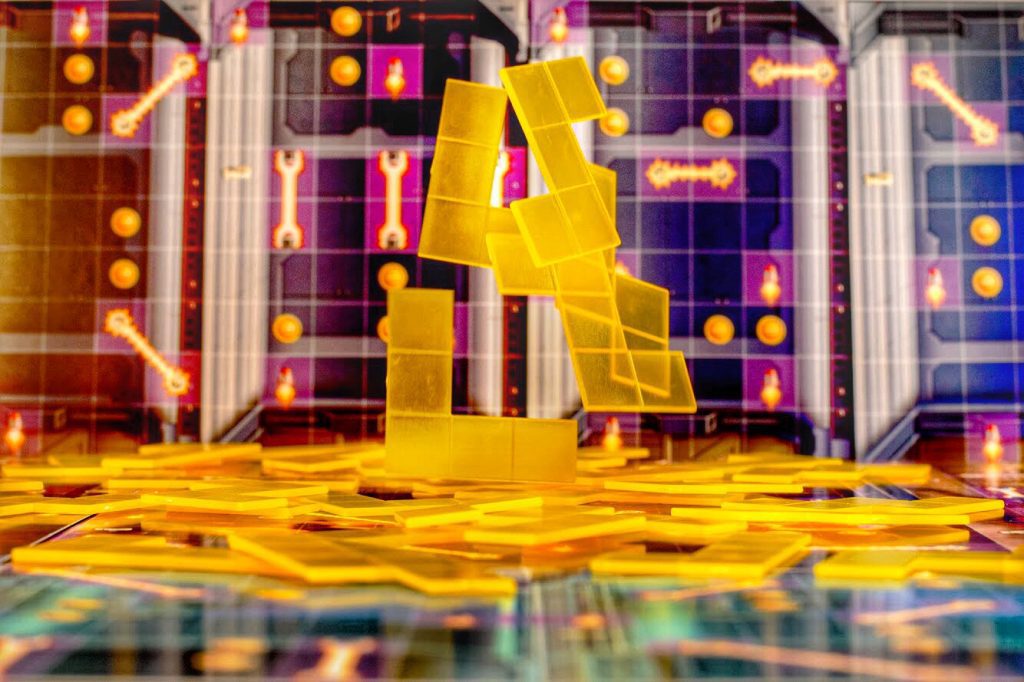
The game is very accessible and inviting because its concept is simple, its design is clean, and it does not overstay its welcome. It can entertain a young audience just as well as it can an audience of heavy strategy gamers by providing enough variability in the missions, gadgets, and lab cards.
The solo gameplay works incredibly well and becomes an even more challenging puzzle with each run as you remove used track tiles from the game. You are constantly struggling with the decision to use a track tile to your advantage now or save it for the next run where it will possibly score more points. For me, a good solo game needs to check 3 boxes: quick and easy setup, reasonable game length, and a difficult, yet attainable goal. Jetpack Joyride satisfies all of these requirements.
There were, however, a few things that I was less enthused about in this game. Unfortunately, there is no mention of the theme or backstory from the digital game in the rulebook or on the back of the box. While I have played its digital form, I imagine that those who were unfamiliar with it might be confused with things like the mention of “Barry” in the rulebook without any explanation as to who he is. I also found the score pad not particularly functional, even though it looked great. It is quite difficult to write on because there are sections of it that are raised and glossy, but this is a prototype so the final version will likely be better. However, none of these minor criticisms were enough to change my enjoyment of the game.
Jetpack Joyride is a beautifully crafted board game that was clearly designed to emulate the feel and tension of the digital game while maintaining its gameplay concepts and transforming them into a fun, quick, real-time experience. Publisher Lucky Duck Games has truly succeeded in meeting their goal to transform this popular video game into a wonderfully exciting analog experience and they have easily risen on my list of publishers to keep my eye on in the future.


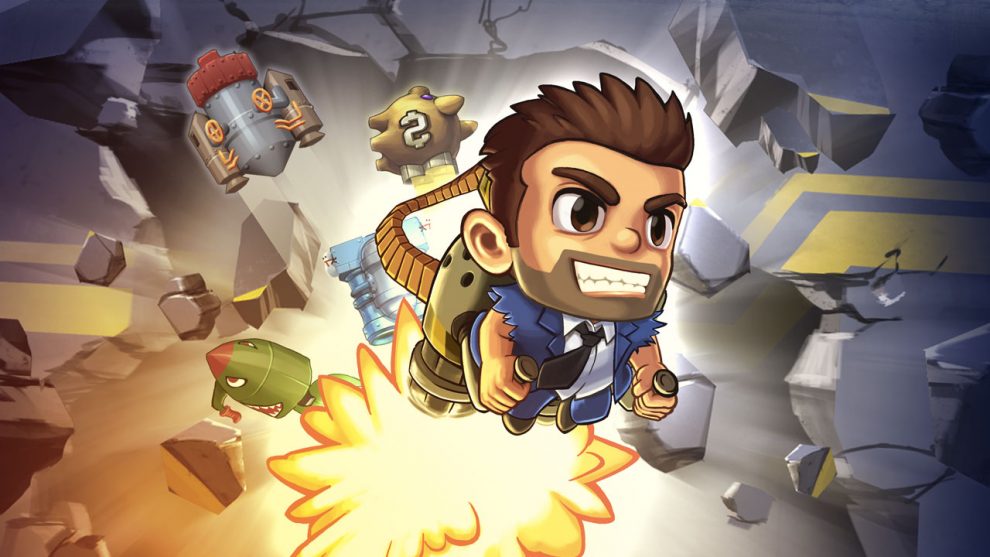









Add Comment